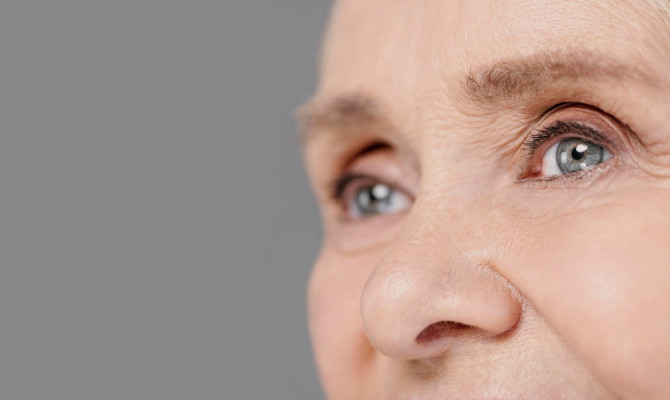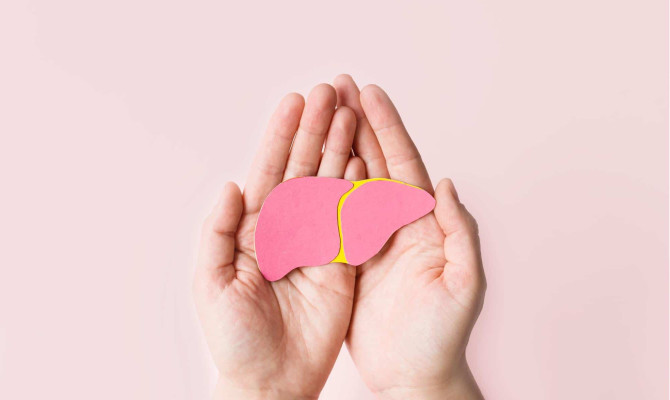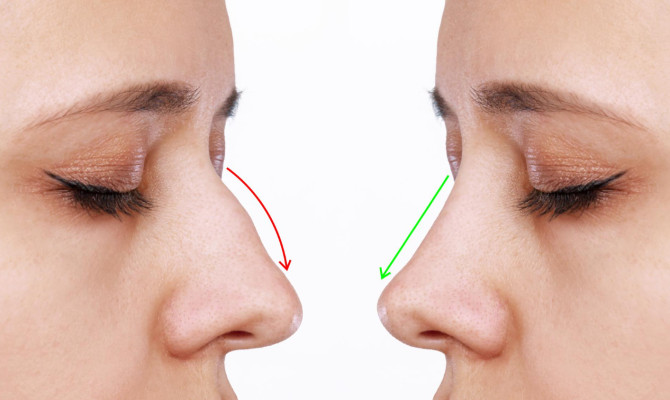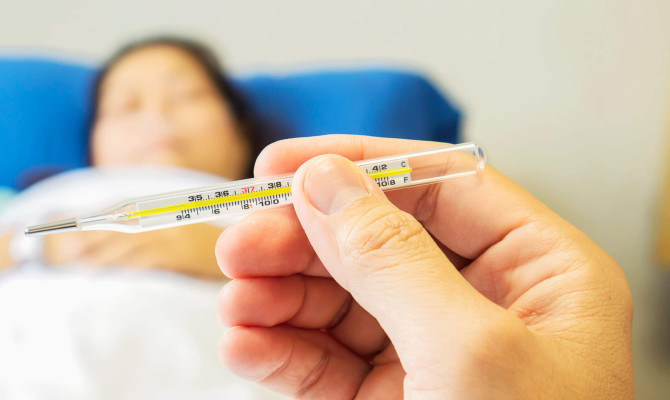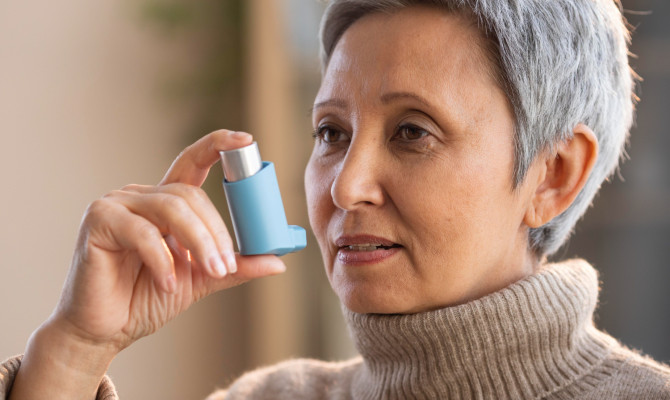Unraveling the Complexity of Skin Cancer: From Symptoms to Prognosis

- Skin Cancer
- 30 Aug 2023
Overview
Overview
The most prevalent form of cancer is skin cancer. There are three most prevalent kinds of skin cancer. Melanoma is far less prevalent than basal cell and squamous cell carcinoma but it is significantly more likely for it to spread to different parts of the body by invading adjacent tissue. Chemotherapy, radiation therapy, Mohs surgery, and cryotherapy are all forms of treatment. Fortunately, most cases of skin cancer are curable if discovered and treated in their early stages. Therefore, it is crucial to consult the physician in presence of any signs and symptoms. 1Overview | Researched based study from National Institutes of Health
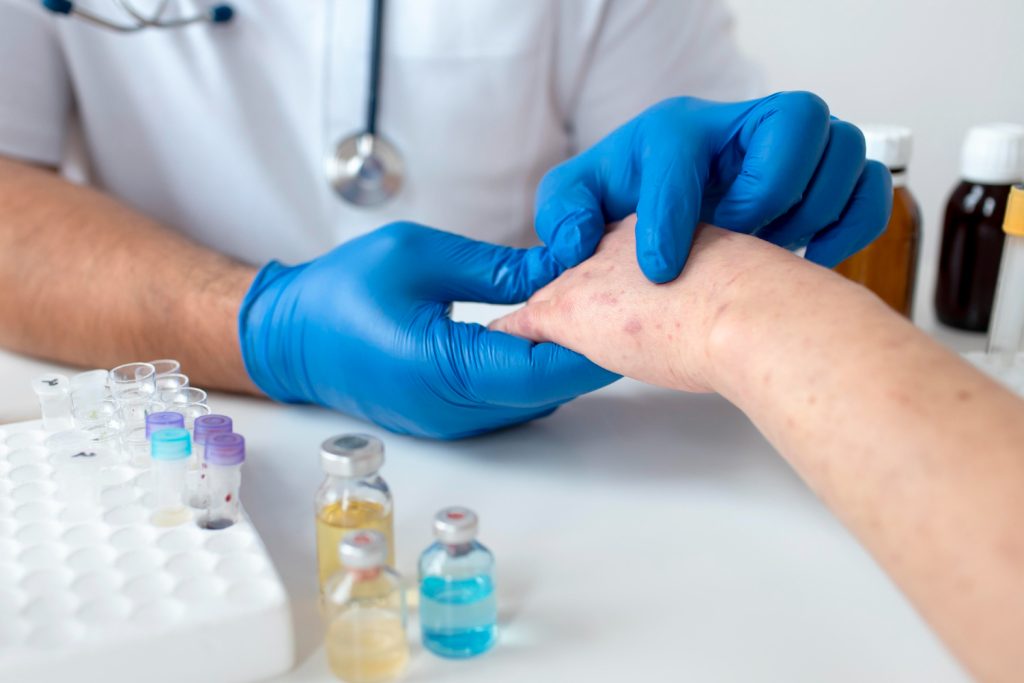
Symptoms
Signs and Symptoms of Skin Cancer
The most frequent form of cancer found in Americans is skin cancer. The skin cancer can affect people at some point throughout their life. 2Symptoms | Researched based study from Cleveland Clinic
Signs of Skin Cancer
Depending on the sort of skin cancer one has, it will seem different. The ABCDE rule will help to identify the warning signs:
- Asymmetry: Unusual form
- Border: A line with blurry or crooked edges
- Color: The color of the mole is multicolored
- Diameter: 6 millimeters in diameter
- Evolution: Expanding, altering in color, shape, and size (This is the most significant indication). 2Symptoms | Researched based study from Cleveland Clinic
Symptoms of Skin Cancer
- A change in the skin, usually a new growth or an alteration in a current growth or mole, is the most prominent warning sign of skin cancer.
- A mole that bleeds
- A fresh mole that changes its size, shape, form, and color
- A pearly or waxy lump present on the ears, neck, and face
- A flat patch or a lump which is pink, brown, or crimson in color
- The scars on the skin which appear to be the same as spots
- Sores with a depression in the middle, recurrent bleeding, and a crusty appearance
- A wound or a sore that does not heal or neither goes away and later reappears
- A scaly, scratchy lesion that may bleed, itch, and crust over 2Symptoms | Researched based study from Cleveland Clinic
Types
Types of Skin Cancer
The three primary kinds of skin cancer are as follows:
Basal Cell Carcinoma (BCC):
- It develops in the basal cells of the lower epidermis.
- BCCs can develop anywhere on the body and usually appears on the chest, abdomen, and legs, but they tend to occur on the neck, head, and arms.
- BCCs frequently resemble a pinkish patch of skin, spherical, a pearl-like lump, or a flesh-colored growth.
- BCCs typically appear after years of continuous outdoor and indoor tanning.
Melanoma:
- This particular form of skin cancer is life threatening as it has the capacity to multiply and spread to other areas of the body.
- Melanoma develops in melanocytes.
- Melanin gives the skin its color and protects it from some of the sun’s harmful UV rays (ultraviolet rays), and is produced by melanocytes.
Squamous Cell Carcinoma:
- This skin condition is developed in the squamous cells of the epidermis.
- Actinic keratoses (AKs) are scaly, dry spots, or patches that appear on the skin of some persons.
- SCC can cause injury and deformity by growing deep into the skin.
- Early identification and treatment may prevent SCC from spreading to other parts of the body. 3Types | Researched based study from American Academy of Dermatology
Skin cancers of other forms include:
- Kaposi sarcoma
- Merkel cell tumor
- Cancer of the sebaceous gland
- Dermatofibrosarcoma protruding 2Types | Researched based study from Cleveland Clinic
Causes
Causes of Skin Cancer
- Overexposure to sunlight, particularly when the person has sunburn and blisters, is the main cause of skin cancer.
- The skin’s DNA is harmed by the sun’s UV rays. UV rays lead to the formation of aberrant cells.
- These aberrant cells multiply rapidly and incoherently, clumping into a mass of cancerous cells. 4Causes | Researched based study from National Institutes of Health
Risks
People at Risks for Skin Cancer
Skin cancer can affect everyone, regardless of color or gender. However, certain groups are more affected than others.
- Skin cancer is more likely in women especially before the age of 50.
- It is around 30 times more common in non-Hispanic white individuals than in non-Hispanic black people or those of Asian origin.
- People who spend an extensive amount of time outside or either at work or in the sun.
- Those who have had a history of sunburn or are easily sunburned.
- Living in a tropical or high-altitude climate.
- People with light-colored eyes, red or blond hair, and fair or freckled complexion are all desirable.
- Those who have a lot of moles or moles that are unusually formed.
- Those having actinic keratosis.
- Men may have higher melanoma rates due to lower rates of protection from the sun.
- Sunburns as a child or adolescent can raise the risk of acquiring melanoma later in life. 5Risks | Researched based study from American Academy of Dermatology
- Have had a previous skin cancer exposure.
- Men and women with previous incidences of nonmelanoma skin cancer are more likely to acquire melanoma than persons without a history of nonmelanoma skin cancer.
- People who have received an organ transplant.
- Those taking immune-suppressing medications.
- People who have received UV light therapy for the treatment of skin disorders that include eczema or psoriasis. 2Risks | Researched based study from Cleveland Clinic
Diagnosis
How is a Skin Cancer Diagnosed?
- First, a medical professional may inquire about any changes in existing skin spots, freckles, and moles, as well as any new skin growths.
- Doctors will next inspect the entire body that includes palms, hands, feet, and soles of feet, ears, scalp, genitals, etc.
- The vast majority of suspicious lesions found during a physical examination will be evaluated with a skin biopsy. 4Diagnosis | Researched based study from National Institutes of Health
Stages of Skin Cancer
Cancer stages reflect the extent to which cancer is present in the body. Skin cancer is classified into four stages. They are stage 0, stage 1, stage 2, and stage 3. The greater the stage, the farther the cancer is spreading and the more difficult it is to treat.
Melanoma Staging:
- Stage 0: The melanoma is located in the outermost layer of the skin.
- Stage I: The melanoma is at low risk and has not spread. Surgery typically works to treat it.
- Stage II: It has certain features that suggest it will return (recur), but there is no evidence of dissemination.
- Stage III: The cancer has spread to skin along with lymph nodes present on adjacent sides.
- Stage IV: The melanoma has migrated to skin or distant lymph nodes, or to internal organs. 2Diagnosis | Researched based study from Cleveland Clinic
Non-Melanoma Staging:
- Stage I: Cancer has spread to the skin’s upper and middle layers.
- Stage II: Cancer has spread from the upper and middle layers of the skin to the nerves or the underneath layers of skin.
- Stage III: Cancer has progressed to the adjacent lymph nodes from the skin.
- Stage IV: Cancer is progressed to organs like kidneys, liver, brain, and lungs at this stage. 2Diagnosis | Researched based study from Cleveland Clinic
Treatment
Treatment of Skin Cancer
Mohs Surgery:
- The dermatologist removes only the abnormal tissue, leaving as much normal tissue as possible surrounding it.
- This treatment is used to treat basal cell and squamous cell cancers, as well as other skin cancers that form near sensitive or aesthetically important areas such as the eyelids, lips, scalp, forehead, ears, and fingers.
Curettage and Electrodesiccation:
- The dermatologist scrapes across the tumor with a device having a looping edge that is sharp to eliminate the cancer cells.
- The remaining cancer cells are then destroyed with an electric needle.
Cryotherapy:
- To freeze the skin cancer the dermatologist uses liquid nitrogen.
- After cryotherapy, the dead cells slough off.
Excisional Surgery:
- The physician removes the tumor as well as the healthy skin around it to ensure that all malignancy is removed. 2Treatment | Researched based study from Cleveland Clinic
Radiation Therapy:
- The radiation oncologist will use high-energy beams to either destroy or prevent cancer cells from spreading and multiplying.
Photodynamic Therapy:
- Physical therapy involves a dermatologist applying medication to the skin. Later it is activated by using a red fluorescent or blue light.
- This treatment kills precancerous cells while keeping healthy cells alone.
Chemotherapy:
- Chemotherapy is the use of drugs by a dermatologist or oncologist to kill cancer cells.
- Anticancer drugs (topical chemotherapy) can be applied directly to the skin if the cancer is limited to the outer layer of the skin, or if the drug is taken orally or through an IV if the cancer is spreading to other parts of the body.
Immunotherapy:
- Immunotherapy is a treatment in which an oncologist administers drugs to encourage the immune system to kill cancer cells. 2Treatment | Researched based study from Cleveland Clinic
Prevention
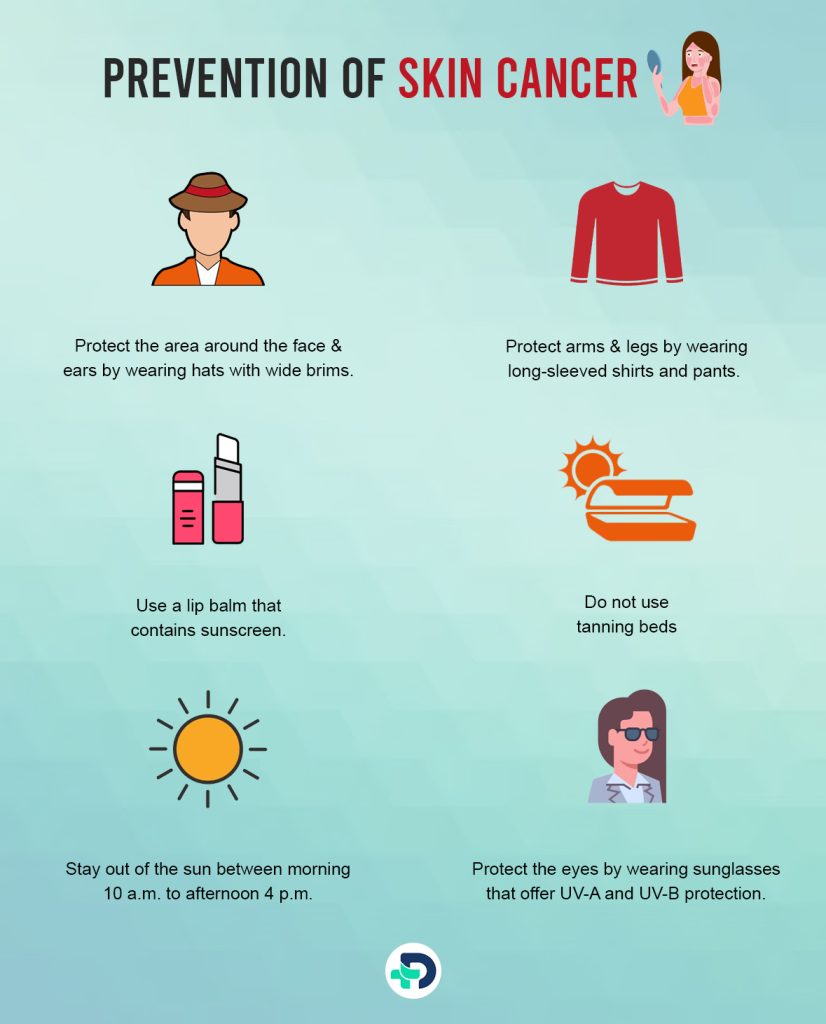
Prevention of Skin Cancer
- Protect the area around the face and ears by wearing hats with wide brims.
- Protect arms and legs by wearing long-sleeved shirts and pants.
- Protect the eyes by wearing sunglasses that offer UV-A and UV-B protection.
- Use broad-spectrum sunscreen containing SPF of at least 30 or more. 30 minutes before going outside, apply sunscreen. Wear sunscreen every day, even if it is gloomy or during the winter. 2Prevention | Researched based study from Cleveland Clinic
- Use a lip balm that contains sunscreen.
- Stay out of the sun between morning 10 a.m. to afternoon 4 p.m.
- Do not use tanning beds. 5Prevention | Researched based study from American Academy of Dermatology
- Inquire with a physician or pharmacist whether any of the drugs make the skin more sensitive to sunlight.
Complications
Complications of Skin Cancer Treatment
Skin cancer chemotherapy can cause symptoms such as:
- Diarrhea
- Nausea
- Vomiting
- Hair fall
Other complications caused due to skin cancer treatment include:
- Bleeding
- Swelling
- Pain
- Scars
- Nerve injury causing loss of sensation
- Infection of the skin
- Tumor regrowth after it has been excised 4Complications | Researched based study from National Institutes of Health
Prognosis
Prognosis
The two most frequent types of skin cancer, squamous cell carcinoma, and basal cell carcinoma, are generally curable in cases of early diagnosis and prompt treatment. Every day, about 20 Americans are killed by melanoma. 5Prognosis | Researched based study from American Academy of Dermatology
The skin requires just as much monitoring as any other body part. Every month, examine the skin for any alterations in skin lesions or new skin growths. Individuals should be taught how to evaluate their skin and when to seek medical attention. Everyone should perform regular skin self-examinations with a dermatologist. What appears to be a minor visual flaw may not be. 4Prognosis | Researched based study from National Institutes of Health
Any feedback on this article?
 This Articles content was accurate
This Articles content was accurate Very Informative Article
Very Informative Article I have a question or a comment
I have a question or a comment
 This article contains inaccurate content
This article contains inaccurate content This article was not helpful
This article was not helpful I have a question or a comment
I have a question or a comment
We appreciate your helpful feedback!
Checkout our social pages
References
-
National Cancer Institute
Overview
-
Cleveland Clinic
Signs and Symptoms | Risks | Prevention | Treatment
-
American Academy of Dermatology
Types
-
National Institutes of Health
Causes | Diagnosis | Complications | Prognosis
-
American Academy of Dermatology
Prognosis | Prevention













